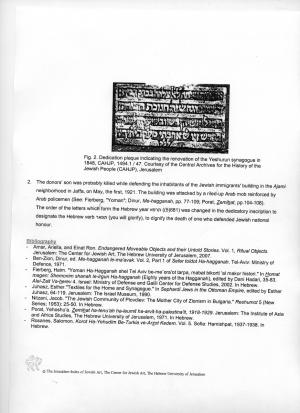Obj. ID: 11853
Sacred and Ritual Objects Reader's Desk Cover, Bulgaria, 1921

The square Reader’s desk cover (?) encloses a central floral motif, which comprises four baskets with flowers, surrounded by similar vases radiating from the corners and small flowers set in-between them. A Hebrew dedicatory inscription, embroidered in square letters is arranged vertically and around the central motif, and reads:
"לק"ק (לקהל קדוש) / הקדש ישורון / לזכר מרדכי חיים טאג'יר נ"ע (נוחו עדן) / שנהרג כ"ג ניסן ./. ת' פ' א' ר' ((5)681;1.05.1921 ) ביפו / בהגנו על כבוד עמנו / מהורי המנוח."
Translation: Dedication to the holy congregation hekdesh Yeshurun, in memory of Mordechai Haim Tager, may he rest in Eden, who was killed on the twenty-third of Nisan (5)681 (1.05.1921) in Jaffa, while protecting the honour of our people, (dedicated) by the deceased parents.” (See: Remarks: no. 2)
The cloth is framed by a wavy flowering branch.
1. Plovdiv is situated in southeastern Bulgaria. Since the 18th century, most of the Jews were living in the Orta Mizar neighborhood, around a courtyard that comprised public buildings, including synagogues, a beit midrash (a house of study) and a slaughterhouse. The Yeshurun synagogue, also named Il kahal grandi, in Judeo-Spanish (Ladino), was built at an unknown date on the ruins of an older synagogue from 1768. The synagogue was renovated in 1848 and demolished during the Communist regime. The Reader’s desk cover is one of two ritual objects that survived from this synagogue and testify to its existence. The other documented object is a Torah crown from 1930, see: Sc.508-64.
2. The donors’ son was probably killed while defending the inhabitants of the Jewish immigrants' building in the ajami neighborhood in Jaffa, on 1 May, 1921. The building was attacked by a riled-up Arab mob reinforced by Arab policemen (See: Fierberg, “Yoman”; Dinur, Me-hagganah, pp. 77-109; Porat, Zemihat, pp.104-108).
The order of the letters which form the Hebrew year תרפא ((5)681) was changed in the dedicatory inscription to designate the Hebrew verb תפאר (you will glorify), to dignify the death of one who defended Jewish national honour.
sub-set tree:
The cloth is worn.
The cloth is apparently a secondary use of a pillow cover, typical of Ottoman embroideries, see: Yohas, “Arigim.”
- Ben-Zion, Dinur, ed. Me-hagganah le-ma'avak. Vol. 2, Part 1 of Sefer toldot Ha-Hagganah. Tel-Aviv: Ministry of Defence, 1971.
- Fierberg, Haim. “Yoman Ha-Hagganah shel Tel Aviv be-me`ora’ot tarpa, mabat bikorti ‘al makor histori.” In Homat magen: Shemonim shana le-irgun Ha-Hagganah (Eighty years of the Hagganah), edited by Dani Hadari, 35-83. Alei-Zait Va-herev 4. Israel: Ministry of Defense and Galili Center for Defense Studies, 2002. In Hebrew.
- Nitzani, Jacob. “The Jewish Community of Plovdiev: The Mother City of Zionism in Bulgaria,” Reshumot 5 (New Series; 1953): 25-50. In Hebrew.
- Porat, Yehoshu’a. Zemihat ha-tenu’a ha-leumit ha-arvit-ha-palestina'it, 1918-1929. Jerusalem: The Institute of Asia and Africa Studies, The Hebrew University of Jerusalem, 1971. In Hebrew.
- Rosanes, Salomon. Korot Ha-Yehudim Be-Turkia ve-arzot kedem. Vol. 5. Sofia: Hamishpat, 1937-1938. In Hebrew.
- Juhasz, Esther. “Arigim ve-rikmot ba-bayit u-be-beit ha-keneset.” In Yehudei Sepharad Ba-Imperia Ha-Ottomanit. Edited by Esther Juhasz, 64-119. Jerusalem: The Israel Museum, 1989. In Hebrew.










